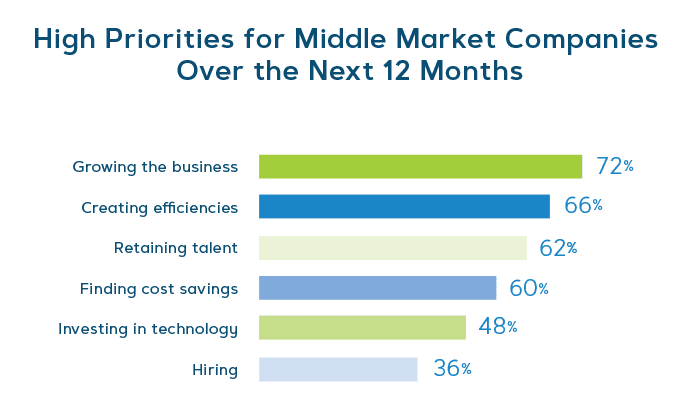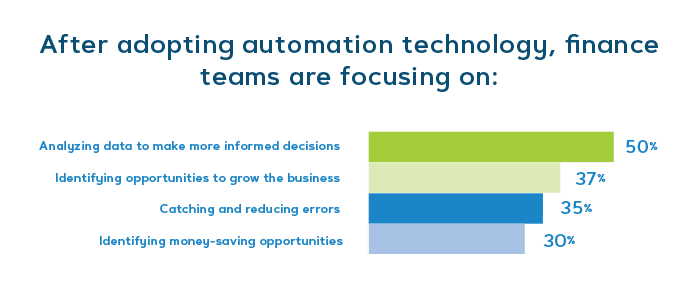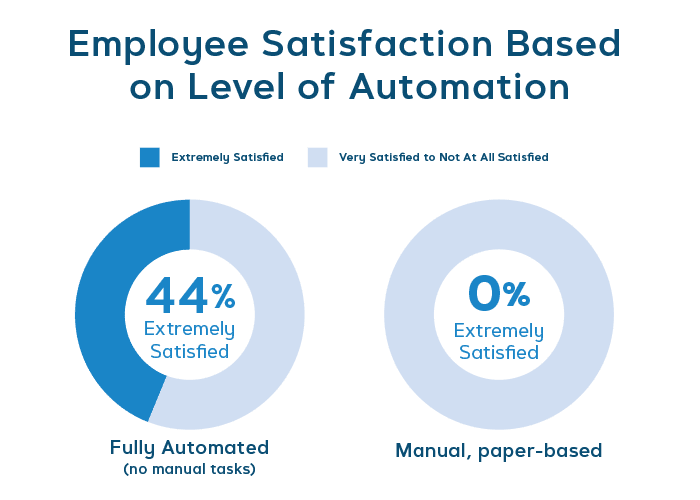As a result of economic uncertainty, organizations across all industries are reevaluating their costs and priorities while leaders are shifting their focus to retain and attract talent amidst growing shortages.
Senior living communities are no exception, especially because it’s a needs-based industry experiencing high demand. People age regardless of economic factors, and higher occupancy rates result in more work for the back office. However, critical staffing shortages are forcing senior living communities to find ways to do more with less.
Leaders can learn from each other, regardless of the industry they serve. We surveyed 500 middle market professionals in August 2022 to better understand how they’re preparing for the recession (if at all) and what their priorities are over the next 12 months.
In this blog, we’ll take a look at what middle market professionals told us (spoiler: a whopping 88% of survey respondents said they are concerned about the current state of the economy). We’ll dive deep into the senior living industry’s concerns and priorities, how a potential recession could impact communities and how the industry is leaning on technology to help navigate a potential recession.
Economic uncertainty and a persistent staffing crisis weigh heavy on senior living executives and staff
While the past offers valuable lessons for the senior living industry, the current business environment looks very different than it did during previous recessions.
In 2008, many seniors were unable to sell their homes – or chose not to – when the housing market crashed and the country catapulted into a recession. Instead, many delayed moving into a senior living community. Reuters reported occupancy rates flattened for the estimated 2.1 million senior housing beds, which are often seen as an alternative to nursing homes and range from independent to assisted living.
The housing market is strong today and provides seniors opportunities to finance moving to a community, despite uneasiness over a potential recession.
“While uncertainty is never good for business, the senior living industry is hopeful that because house prices are high, many seniors can afford to sell their home and move into the facilities, whether it is needs-based or not. Many people are looking for an easier, more convenient lifestyle and now is the time for them to capitalize on the market to sell their home and make the move to a senior living or retirement community.”
Traci Capraro, Senior Director & Business Line Executive, Emerging Markets for AvidXchange
More demand means more work for all senior living staff
With an increase in demand, the senior living industry is concerned about keeping up with an increase in workloads. An unrelenting staffing shortage continues to hinder their ability to grow or even survive. Additionally, facilities are competing against their competitors and other industries to attract and retain the same talent – and it’s driving up employment costs.
A survey conducted by the American Health Care Association and National Center for Assisted Living found that 98% of nursing homes and other long-term care facilities are experiencing moderate to severe staffing shortages. Three out of five nursing homes have had to limit admissions because of the problem, and nearly three-quarters of facilities surveyed are worried they may have to shut their doors because they don’t have the people they need to stay in business.
The senior living industry is not alone in its struggle to find, finance and keep the talent they need. Nearly two-thirds (62%) of respondents in our survey across middle market companies stated retaining talent is a high priority for their business over the next 12 months.
How are businesses coping with the shortage and the higher price of talent?
They are searching for better ways to do business.

Sixty percent of our survey respondents said they are looking for ways to reduce costs, while sixty-six percent said they are looking to create efficiencies to increase productivity and improve profit margins. Capraro said these priorities hold true in senior living as the staff, too, fight to do more with less.
Senior living facilities and retirement communities turn to technology to enable growth
One of the most impactful ways to create time and cost-saving efficiencies is through investments in technology. Nearly half (48%) of our survey respondents said “investing in technology” is a high priority for their business over the next 12 months.
Technology investments within the senior living space save staff valuable time while also enhancing patient care, including:
- Voice-controlled personal assistants help with daily tasks such as ordering dinner or turning off the lights
- Wearable devices provide 24/7 monitoring of vitals and daily activity
- Telehealth services save nursing staff from having to transport patients to and from in-person medical visits
- Accounts payable (AP) automation transforms the back office by creating efficiencies
In fact, 36% of survey respondents are focusing their technology investment on automation, including AP solutions that replace manual finance processes like invoice processing and bill pay which are critical to operations. Automating the tasks frees staff for more strategic, satisfying work and often enables facilities to handle greater workloads without additional hiring.
Organizations that have already adopted finance automation technology are reaping valuable benefits:
- 50% of those surveyed said they are analyzing the data the solutions provide to make more informed decisions
- More than one-third are identifying opportunities to grow the business
- 35% cite the ability to catch and reduce errors, like duplicate payments, as a top benefit of their investment

The importance of automation technology was also uncovered in AvidXchange’s 2022 AP Professional Career Satisfaction Survey conducted in partnership with The Institute of Finance & Management (IOFM). The survey found that the more automation in a company’s finance department, the more satisfied finance professionals are with their roles and the more they agree with the statement: “My job utilizes my skills and abilities as much as it could.”
More satisfying roles make it easier for senior living facilities and communities to hold onto staff, and it’s also a powerful hiring tool. Organizations that invest in AP automation often have an advantage over those that still rely on cumbersome, time-intensive ways of doing business.

Are you ready to help your senior living community prepare for the future?
While no organization, senior living facilities and communities included, can predict whether or not a recession is imminent, they can prepare for the potential by learning from others, understanding their priorities and investing in technology to modernize and protect their businesses.
For more information about how automation can fortify your organization, download our white paper, “How Middle Market Finance Teams are Preparing for a Recession.”



